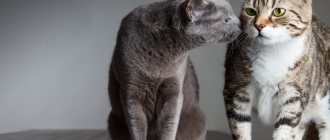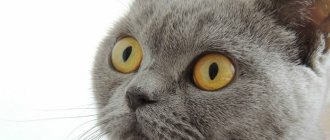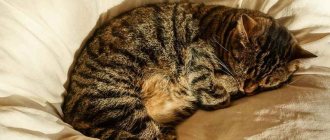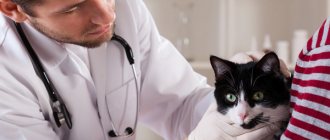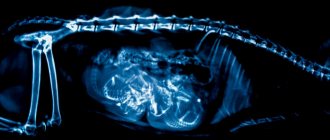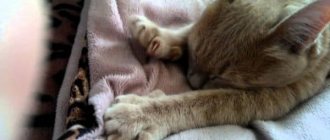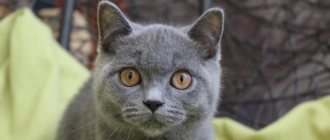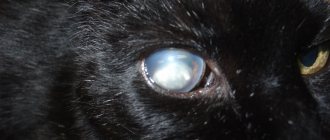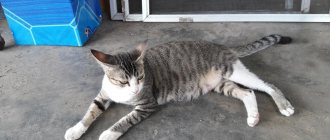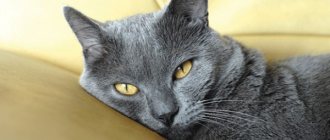All about mating a British cat. Dates of readiness for fertilization, choice of partner, preparation for childbirth. The course of pregnancy and its stages. Why can't you breed a British cat with representatives of other breeds?
British cats come in different sizes, but in general they are similar to representatives of noble and medium breeds. They have a powerful body and strong limbs.
The neck is short and strong, the head is large with full cheeks and a short muzzle. Most British women have amber or copper eyes, but there are blue and green ones. Their shape is round and wide.
As the cat grows, it gains up to 4-5 kg. At 3-4 months, the legs grow sharply and the gait is awkward. By 6 months, the proportions are equalized, and the animal acquires gracefulness and carries its head with dignity.
The character of British women is created for a comfortable life next to a man and his family. They can go unnoticed if the owner is in a bad mood or does not have time for play or affection. They become attached to a person, but do not require constant attention.
Features of estrus
In British cats, the first heat begins at 6-10 months. However, it is not customary to knit it during this period. The favorable age for crossing is 1.3 years and above. It is also not recommended to breed a cat for the first time after 2 years. It is advisable to wait until the 3rd heat.
The frequency of this phenomenon varies. For most, it occurs after 15-24 days, but depending on the condition and characteristics of the body, the timing shifts. The right time for fertilization occurs no earlier than the second day. In total, estrus lasts on average 3-8 days.
Important: If you do not plan to breed a cat, then the optimal age for sterilization is 1.5 years. It has time to form by this point, but the hormones do not cause harm to the body.
Standard signs of estrus:
- Behavior change;
- Walking on bent legs;
- The cat withdraws its tail and crouches if you press or stroke near the base of the tail;
- Transparent discharge from the loop;
- The pet licks itself more often;
- Loud and inviting meows.
Changes in taste preferences are also possible. The cat can pester other pets, even neutered ones, sometimes people and rub against things with a strong odor.
Mating of a British cat
Experienced breeders recommend bringing a cat into a male's territory. Otherwise, there is a risk that someone else's pet will start marking and worrying. If a cat has favorable days, the cat will immediately understand this.
They are left alone in a closed room. At first, the cat may show aggression, but prolonged fighting with the partner indicates that she is not ready to mate. It happens that a British woman's heat is interrupted during a trip due to stress.
If the mating went well, the cat stops being nervous, becomes calm and stops yelling. She can let a cat come to her and lie with him in an embrace.
How mating occurs among Bengals: selection of a partner, mating technique
The Bengal cat is a rather difficult breed to breed. The species was shaped by specialists over many years - certain genes were fixed, others were eliminated. Competent selection of partners requires extensive knowledge, experience, understanding of what an ideal Bengal cat should be like and what genes are responsible for this. And if the owner of a Bengal cat is not a professional breeder, for consultations in selecting a groom, it is better to contact the nursery or club where the pet was purchased. The standard ad “looking for a Bengal cat for a kitty” may be the wrong step. The choice of a pair depends on several important parameters, and the color and type of tabby are not the most important ones. You need to look for a mating partner not only who is outwardly beautiful, affectionate, healthy, but also one who meets the standard. Even not very noticeable flaws - pale spots, small vertical stripes, short legs, a light body - indicate that the cat carries non-ideal genes, and the litter from it may deviate even further from the standard.
Features of mating Bengal cats
Now professionals allow mating of Bengals exclusively within the breed. The appearance of mixed breeds, for example, the mating of British and Scottish cats with Bengal cats, which has become fashionable, is not welcome. Of course, no one can prevent the owner from crossing his pet with another breed, but the offspring will not be considered Bengals. So, to the question that appears on the networks, whether it is possible to breed a Scottish cat with a Bengal (or a Bengal with a Scotsman or a Briton), official felinology answers with a categorical no.
The only exception is the permission to breed Bengal cats with their ancestors - wild Asian leopard cats, in order to refresh the genes, introduce interesting new qualities or strengthen existing ones. Such work is possible in large specialized nurseries; in private, few people will be able to find a wild animal for mating.
How is the mating done?
The mating season must be planned on the cat's territory - the most natural option, since the male feels more confident in his home. The cat is left with the groom for several days - it is advisable that the act of mating be repeated. How many days the mating will last depends on the animals themselves. Sometimes they take several days to get used to it, get to know each other, and sometimes the process is completed immediately, and this is also correct. One of the signs of successful mating is a noticeable change in the behavior of the female - she calms down, stops rubbing and meowing. An ultrasound scan after two weeks can indicate the success of the case with confidence. Born Bengal kittens are the property of the owner of the female, and the owners of the cat that was crossed with her receive either payment or a “maintenance” kitten. If it turns out that the cat did not become pregnant, the mating is repeated in the next cycle of her readiness (usually the mating with the same cat is already free).
Having conceived the continuation of the cat family, the owners must check the pedigree of their pet and partner - titled purebred parents, the presence of all documents and vaccinations are very desirable. It is worth inquiring about the type and fate of previous litters - older children from a parent or parent, then the owner will have more confidence in the purebred offspring without genetic problems.
Read all about the Bengal breed in the Main article
Preparation for mating
A British cat must be dewormed 7-14 days before mating. Vaccinations against standard diseases and sexually transmitted infections are required, given no earlier than 12 months ago, but no later than 25 days.
Important: You should not wash your cat before breeding. This will hide its natural smell and scare the cat away.
The cat must not have fleas, ear or subcutaneous mites. It is advisable to do tests for common diseases in the breed.
A British woman may be a carrier of a gene that transmits problems with the eyes and heart. Additionally, the blood type is determined. If it is different from the cat’s group, then after birth measures are taken to prevent the death of newborn kittens.
Prepare a carrier in which the cat can rest while on foreign territory. It will help you get used to it faster. You need food for 4-6 feedings.
Before mating, the claws are shortened so that the pet does not scratch the cat after mating. Hitting a male's face is considered a ritual and obligatory action. There have been cases of cat eye injuries.
Exterior manufacturers
In addition, you should pay attention to the exterior of the manufacturers in general. You should not bring your pet with a cat that has too light a bone, a small head or a stretched body. Particular attention should be paid to the applicant's eyes. They should not be oblique. It is also not allowed to have an extra claw on any of the paws. Both of these characteristics will certainly be inherited.
Mating of British cats is usually carried out only with cats that have diplomas. The pedigree should be checked up to the fourth generation. Of course, it’s better if there are champion animals in dad’s family. You can't mix Britons with Scots.
Pregnancy and childbirth
British cats, like others, are pregnant for 64-70 days. If fertilization does not occur, then estrus begins 3-4 weeks after the unsuccessful attempt. The first signs of pregnancy are visible at 3 weeks.
The nipples become pinkish and slightly enlarged. The British woman becomes more tender, demanding affection and attention. Then the rest time increases.
After 4 weeks, the fruits and their movements can be felt. In one litter, British women give birth to an average of 3-5 kittens, in some cases multiple births are possible - up to 9 kittens.
This factor depends on heredity; if a female cat in her family gave birth to more than 5 kittens, then she has every chance of the same result.
A few days before giving birth, the expectant mother is looking for a place where she can comfortably produce and raise her offspring. As a rule, these are drawers or cabinet compartments, the space under the sofa, or the bathroom. Some cats come to their owners' beds to give birth.
Important: In the second half of pregnancy, cats are not allowed to jump from heights, play active games, or have contact with other animals.
Set up a box or house with bedding made of dense materials that are rigidly attached to the walls. Soft and thin sheets are unsuitable; during childbirth, the cat may accidentally wrap the kitten and cause harm to it.
Childbirth sometimes goes unnoticed and without human intervention, but it is better to observe the process and be prepared for unforeseen situations. British women in most cases give birth on their own; a caesarean section is rarely necessary.
The cat notifies about the beginning of the process by restlessness and meowing. You need to talk to her kindly and prepare the maternity ward. The process can last several hours, up to a day.
The kittens come out in bubbles with liquid, the mother gnaws them herself, and then removes the umbilical cord. After giving birth, the cat produces colostrum, which is nutritious and very important for babies. Soon it is replaced by milk.
Breed description, standard
The British cat is distinguished by its strong build, plush coat, and great physical strength. Britons are heavyweights among domestic cats. This breed is brachycephalic - having a round head with a short nose. The roundness and power of the head is emphasized by developed cheeks. Well-filled whisker pads and chin create the effect of the famous “Cheshire cat smile.” Representatives of the British breed have especially pronounced sexual dimorphism - males differ significantly from females. Cats are much more massive, larger, their weight often reaches 10-12 kg. Cats have a more modest body weight - 5-7 kg, and their cheeks are less pronounced.
Table – Breed standards of British cats
| Head | Large, round, with a powerful short neck. The full face forms a regular circle. The profile is shortened due to the nose, there is a fairly pronounced transition between the bridge of the nose and the forehead, and a flat area between the ears. Well-stuffed underarms and cheeks, a strong chin. |
| Ears | Widely spaced, short, on a wide base. |
| Eyes | Round, color (orange, green or blue) depends on the color variant. |
| Torso | The size is medium to large, with a massive chest, scapular region, and back. |
| Paws | Powerful, short. |
| Tail | Short, almost the same diameter along the entire length, without a point at the end. |
| Wool | Plush - soft, thick, dense, not adjacent to the skin. |
The table shows the main averaged parameters. Each feline system has its own nuances of British breed standards.
Colors of British cats
Representatives of the British breed can have almost any color variant that exists among domestic cats.
Table - Main color types of British cats
| Solid (plain, solid) | Classic colors - blue and lilac Less common are black, white, chocolate, red, pink. Rare - cinnamon, fawn. |
| Patterned (tabby) | Brindle (striped), spotted, marbled. With a pattern of different colors on different backgrounds - gold, silver. |
| Bicolor | Two-color - with spots on a white background. |
| Color point | British cats have an acromelanic color (like Siamese) - with a darker muzzle, paws, ears, tail and blue eyes than the body. |
| Shaded | With different colors along the length of the hair (one of the varieties of this color is chinchilla). |
| Tortoiseshell | Found only in cats - a combination of black and red in different tones. |
Breed faults
Breed defects are shortcomings in the pet's exterior. Representatives of the British breed with minor similar defects can participate in breeding, but do not receive top marks at exhibitions. Males and cats with severe deficiencies cannot participate in breeding, while remaining charming and attractive pets. Such disadvantages include:
- too light bones, thin and long paws, tail;
- weak chin, poorly defined cheeks;
- too short and snub-nosed or, conversely, long nose;
- close-set, elongated ears;
- white spots on a solid or point coat;
- aggressive or cowardly behavior.
British cat with heterochromia
How do British cats differ from Scottish cats?
British and Scottish cats have certain similarities and are often confused. However, these are two different breeds, interbreeding between their representatives is not encouraged. Kittens from such matings are considered outbred by most felinological systems. Therefore, there are no “British Fold” cats in the felinological world. Fold cats and cats with obvious signs of the British breed are mestizos of British and Scottish parents, the fruits of interbreed matings that are not recognized as purebred animals. These are cute pets, but they are not suitable for further breeding.
Table - Main differences between British and Scottish cats
| Part of the body | British cat | Scottish cat |
| Head | Round, with pronounced cheekbones, chin, and underarms. A sharper transition from the nose to the forehead than the Scots. | The shape of the head in profile is smoother, more rounded than that of the British, the forehead is somewhat steeper. Full face - a more pronounced pinch (the transition between the cheekbones and mustache pads). The face of the Scottish cat is very reminiscent of an owl. |
| Ears | Always straight, widely spaced, rounded. | Straits (straight ears) have narrower, pointed, closer ears than the British. In Scottish Folds (Scottish Fold), the ears are tilted forward, ideally pressed to the head. |
| Frame | Cobby-type cats are stocky, muscular cats with strong, wide bones. | Less “compact” animals with a more elongated, “light” body. |
| Paws | Short and thick. | Longer, medium thickness. |
| Tail | Short, thick, rounded at the end. | Long, medium thickness, pointed. |
| Character and temperament | They are quite phlegmatic, not inclined to play a lot, and often communicate with other animals and people. They rarely tolerate fellow tribesmen in the house. | More active than the British, they love communication with people and pets more, and get along more easily with their relatives. |
